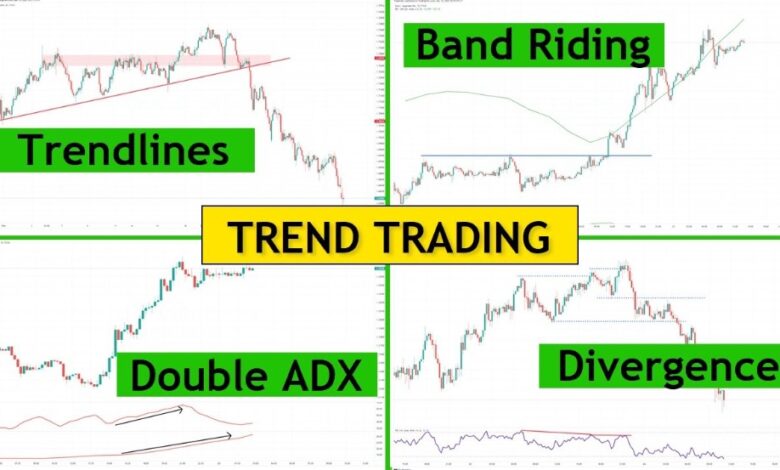Learn Trend Trading And Best Strategies That Work

Trend trading is a popular strategy in the financial markets that involves identifying and capitalizing on the directional movement of an asset over time. This approach aims to profit from the prevailing trend, whether it is upward or downward. Successful trend trading on stock investing apps requires a combination of technical analysis, risk management, and discipline. Here, we will delve into the fundamentals of trend trading, explore effective strategies, and provide insights into how to implement them successfully.
Understanding Trend Trading
Trend trading is based on the premise that asset prices tend to move in sustained trends over time, driven by factors such as market sentiment, economic indicators, and geopolitical events. Traders seek to identify these trends and enter positions in the direction of the prevailing market movement to capture profits. Trend traders typically aim to ride the trend until signs of a reversal or exhaustion emerge, allowing them to exit the trade with a profit.
Key Principles of Trend Trading
1. Identifying Trends: Trend traders use technical analysis tools such as moving averages, trendlines, and chart patterns to identify and confirm trends. They look for higher highs and higher lows in an uptrend and lower highs and lower lows in a downtrend.
2. Risk Management: Effective risk management is crucial in trend trading to protect capital and minimize losses. Traders often use stop-loss orders to limit potential losses and adhere to proper position sizing to manage risk.
3. Patience and Discipline: Trend trading requires patience to wait for high-probability setups and discipline to follow the trading plan consistently. Emotions like fear and greed can lead to impulsive decisions that may undermine trading success.
Read also: Navigating the Forex Market: How to Select a Broker That Matches Your Trading Style.
Best Strategies for Trend Trading
1. Moving Average Crossover Strategy
The strategy described involves utilizing two moving averages, typically the 50-day and 200-day moving averages, to identify potential trend reversals in the financial markets. When the shorter-term moving average, such as the 50-day moving average, crosses above the longer-term moving average, like the 200-day moving average, it signifies a potential uptrend in the market. Conversely, when the shorter-term moving average crosses below the longer-term moving average, it indicates a potential downtrend. This crossover of moving averages serves as a signal for traders to consider entering or exiting positions based on the direction of the trend.
By using this strategy, traders aim to capitalize on the momentum and direction of the market, leveraging the insights provided by the interaction of these moving averages. The crossover of moving averages can help traders identify shifts in market sentiment and potential changes in trend direction, providing valuable signals for making informed trading decisions.
2. Breakout Trading Strategy
Breakout trading is a strategy where traders enter a trade when the price breaches a significant resistance level in an uptrend or a key support level in a downtrend. This strategy capitalizes on the momentum generated by the price breaking through these critical levels, signaling a potential continuation of the trend in the same direction. Traders seek strong momentum and volume confirmation to validate the breakout, ensuring that the price movement is supported by substantial trading activity and market interest.
When the price breaks above a significant resistance level in an uptrend, it indicates a potential upward movement, while breaking below a key support level in a downtrend suggests a potential downward movement. Traders typically wait for confirmation of the breakout through factors like increased volume and strong price movement to confirm the validity of the breakout signal. By entering trades based on these breakout signals, traders aim to profit from the subsequent market movement in the direction of the breakout, leveraging the momentum and potential trend continuation.
3. Trendline Trading Strategy
Trendlines are diagonal lines plotted on a price chart that connect a series of successive price points, either highs or lows, to identify the prevailing market direction. Trendline trading involves entering trades when the price bounces off a trendline in the direction of the prevailing trend, providing potential entry and exit points.
Trendlines can be used to identify potential trade signals, such as when the price touches the trendline and bounces back in the direction of the trend. This strategy is based on the premise that the trend will continue, and the price will bounce back from the trendline. Traders can use trendlines to enter trades in the direction of the trend, placing stop-loss orders under the previous swing low in an uptrend or above the previous swing high in a downtrend2
4. Pullback Trading Strategy
Pullback trading is a strategy that capitalizes on temporary price retracements against the prevailing trend, offering traders opportunities to enter positions at favorable prices. The premise is that markets rarely move in a straight line, and even in strong trends, price corrections occur as traders take profits or make counter-trend trades.
The goal is to enter trades in the direction of the prevailing trend, anticipating that the trend will resume after the pullback. Traders use stop-loss orders to limit potential losses if the trend does not resume as expected. By entering trades during pullbacks, traders aim to achieve favorable risk-reward ratios, as the stop-loss can be placed relatively close to the entry point.
Pullback trading requires careful analysis of market conditions, trend strength, and risk management. While it can be a profitable strategy, traders must be aware of the potential for false signals and the difficulty in precisely timing entries.
Implementing Trend Trading Strategies
1. Backtesting: Before trading with real money in the best stock analysis app, backtest your chosen strategies on historical data to assess their performance and refine your approach.
2. Risk Management: Set stop-loss orders to limit potential losses and use proper position sizing to manage risk effectively.
3. Monitor Market Conditions: Stay informed about economic events, news releases, and market sentiment that may impact the trend, and adjust your trading strategy accordingly.
4. Review and Adapt: Regularly review your trades, analyze performance, and adapt your strategies based on changing market conditions and feedback from your trades.
In conclusion, trend trading offers a systematic approach to capturing profits from market trends by identifying and following the prevailing direction of asset prices. By understanding the key principles of trend trading, implementing effective strategies, and maintaining discipline and risk management, traders can enhance their chances of success in the dynamic world of trend trading.






